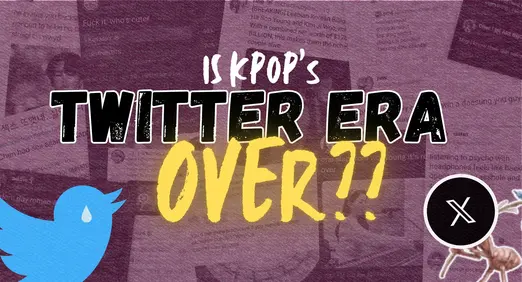Remember when Twitter, now X, felt like the ultimate backstage pass for every Kpop stan? Back in the days, the blue bird served up real-time chaos, fanwars, and late-night selcas that made fans feel a heartbeat away from their idols. Instagram hardly existed in the idol playbook, and TikTok was just a glimmer on the horizon.
Fast-forward to 2025, and that once-electric timeline feels… quieter.
karl marx vs jin from bts This shit was Insane https://t.co/eUf37nM0d5 pic.twitter.com/aZT2D84JWK
— 🐾 Lesbian Jesus (@SpirkYaoi) January 29, 2023
What Made Twitter the Default Platform
Twitter’s magic was its speed and simplicity. Timelines moved in seconds, hashtags united global fandoms, and idols could toss out a casual “good night” that instantly reached millions. Back when Instagram was just for artsy filters and TikTok hadn’t been born, Twitter filled every gap. It offered instant trends and that wild sense of rawness and authenticity.
#뷔생일ㅊㅋ 두둥…..!!!!ㅋㅋㅋㅋㅋㅋㅋㅋㅋㅋㅋㅋㅋㅋㅋㅋㅋㅋㅋ -슙 pic.twitter.com/YM8zf569IH
— 방탄소년단 (@BTS_twt) December 29, 2014
More Controlled “Authenticity”: Weverse and TikTok
These days, staying authentic doesn’t mean being completely unfiltered. It just means doing it in a space that feels more protected. Platforms like Weverse create that kind of environment, where idols can share handwritten notes, voice messages, and everyday selfies without worrying about trolls taking over the comments.
TikTok brings its kind of candid energy, with short dance clips, day-in-the-life vlogs, roommate pranks, and unexpected laughs popping up on fans’ For You pages. Both platforms manage to keep things genuine while still keeping the noise out, something Twitter continues to struggle with.
@maroo_ghost9 processed food brain 😀🧠 #GHOST9 #고스트나인 #PRINCE #프린스 ♬ original sound – GHOST9 Official
Leaning Toward Visuals
Kpop has always been a feast for the eyes, from sparkling stage outfits to intricate choreography and glossy photobooks. Instagram’s polished grids and Stories take that visual storytelling to the next level. Younger fans want content they can screenshot, crop, and save as lock screens.
Compared to that, Twitter’s text-leaning approach just doesn’t hit the same. Deep dive threads still exist, breaking down lore and fan theories, but these are now just as likely to be narrated on Reels and TikTok, with voiceovers and visuals pulling fans in even faster. Most of the excitement has shifted toward photo dumps, challenges, and edits that loop endlessly in a scroll filled with color, sound, and instant engagement.
Algorithms Give Underdogs Viral Wings
Instagram’s Explore page and TikTok’s algorithm also work like talent scouts. One catchy choreo snippet from a rookie group can explode overnight, jet-packing them onto global playlists before their fandom even has a name.
That level playing field once belonged to Twitter’s trending tab, but chronological feeds can’t compete with AI that hand-delivers content a user is likely to love. Smaller groups see real hope in going viral through visuals and sounds rather than trying to climb old-school hashtag mountains.
@offcl_aura 📀 Cupid (Twin ver.) [ Live in Studio] | FIFTY FIFTY (피프티피프티) [TH Translation: Lalita C. @Thethaiger] #Cupid #FIFTYFIFTY #fyp #fypシ ♬ Cupid (Twin Version) – FIFTY FIFTY
Bots, Spams, and Fan Fatigue
Since Twitter became X, timelines feel messier. Verified checkmarks lost meaning, spam replies multiplied, and bot armies hijack hashtags meant for comeback celebrations. Constant clean-ups leave fans exhausted, searching for safer, less chaotic spaces.
Add to that a growing awareness of mental health, and many stans choose to curate their online homes. Private Discord servers, subreddit threads, or simply fresh TikTok feeds often feel lighter and more fun than duking it out with spambots on X.
Lesbian Korean Billionaires, Ha Soo Young and Kim Ji Woo, marry. With a combined net worth of $170 BILLION, this makes them the richest couple alive.
pic.twitter.com/yREycBX9lS https://t.co/467hdnrP0z— Kimeniverse (@kimendedly) May 25, 2024
So, has the legendary Kpop Twitter fandom bubble popped? Not quite. It hasn’t disappeared, but fans drifted to platforms that feel more in tune with how they connect today. Instagram is where the stunning visuals live, TikTok brings back that spark of “authenticity”, and Weverse gives fans a quieter, more curated space to bond with their faves.
Twitter still lights up during award-show chaos and comeback countdowns, but the fandoms now pulse loudest far beyond its timeline.
